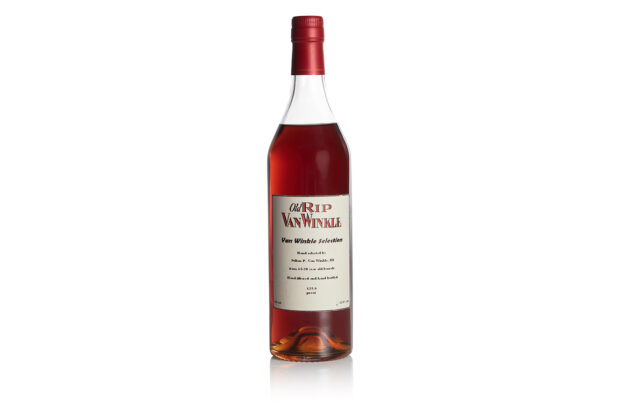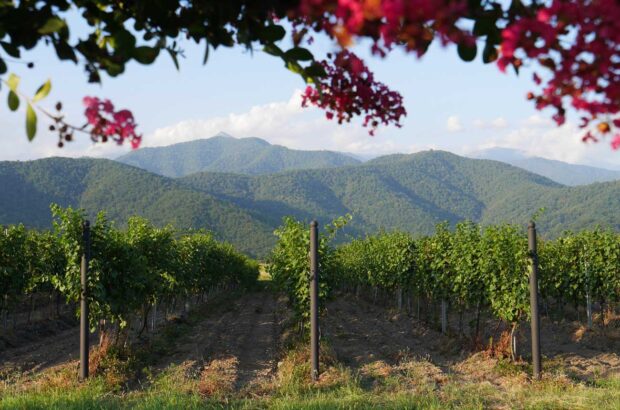Andrew Jefford visits the high-altitude vineyards of Crete and finds an ancient wine culture in renaissance...
The sun shone; the wind howled. Ten degrees of latitude further north, and this would be a ski run. Crete, though, is the chin on Europe’s face; we’re even south of Pantelleria here.
There was indeed snow on the three mountain ranges which give Crete its brooding physical presence. Here, though, at 650 metres, there was just stone, light, mute vines – and a picnic table that threatened to soar in the blast, like the spying griffon vultures overhead.

The high altitudes in Crete bring snow. Credit: Nikos Somarakis
This was Vassilis and Anna Topsis’s Pirovolikes Vineyard, and there was a bottle of their 2014 Vilana, made by Lyrarakis, on the table, alongside Anna’s home-baked meat, vegetable and cheese pastries. As we pitched up (literally: the track to the vineyard was steep and deeply rutted), she was gathering wild golden thistle (scolymus, in fact a member of the chicory family) to cook later. We ate the pastries and drank the wine. It was fresh and incisive, like the wind: a splash of lemon, shattered stones, bitter herbs.
They were proud of the moment, and the wine; and I was, in a way, awed by them, for I could see that neither wine nor the moment was easily won from nature. They keep goats, for milk, cheese and meat; they bake their own bread, in a wood-fired oven they light every two weeks. They live from the vine and the olive.
Like their forebears – for the last 3,500 years. We’d just visited the Minoan wine-press at Vathipetro, part of a palace complex built around 1580 BCE (probably less than a hundred years after the Santorini explosion). Later that afternoon, in the village of Agios Thomás, my companions and I stood on the edge of a giant, open-air treading tank – chiseled out of a limestone boulder the size of a small house during the centuries when Crete was the productive overseas Republic of Venice known as Candia (1205-1669).

Cretan limestone. Credit: Andrew Jefford
There’s no automatic correlation, of course, between the length of a tradition and its present-day call on our attentions – but in Crete’s case, something very interesting is going on. Here’s why.
It’s big: this is the Mediterranean’s fifth largest island, and the main wine-growing area, set back from Heraklion, is Greece’s second largest wine district. But it’s a late starter in the modern wine race: phylloxera, astonishingly, only reached Crete in the 1970s.
Not only is replanting recent, but the island had the double handicap (or so it now seems) of having been replanted largely with international varieties, since that was what domestic and tourist consumers wanted at the time. Crete, though, has a splendid suite of indigenous varieties – and it’s wine from those which has best export potential. They’ve stepped shyly into the limelight as Greece’s successive economic crises have eroded domestic consumption, leading Cretans to rethink the vineyard mix.
Remember, too, that most Cretan viticulture is high-altitude: up to 858 metres above sea level. That fact, combined with evidently happy adaption of indigenous varieties and some first-class limestones and marls, means that Cretan wine defeats the expectations generated by its latitude.
Most of it (68 per cent) is white, for a start, and it’s the whites which for the time being show the most technical assurance. They’re usually fresh, scented, nuanced, haunting and graceful, notched between 12.5% and 13%. The reds are a stronger, often light in colour, but remarkably structured – and wines of both colours impress for their complex, secondary flavour profiles, something seemingly built into the Greek gene bank: so much more than simple fruit, and very food-friendly.
Ah yes, food. Why aren’t there more Cretan restaurants around the world? With its delicacy and colour, its embrace of vegetables and its retrained use of meat, its use of a unique range of indigenous herbs and foraged greens with simply prepared fish and cheese, and its artful celebration of olive oil and of bread, both fresh and dried, it seems perfectly in tune with the gastronomic zeitgeist: light on the stomach, pretty on the eye, rooted in a culture and a place.
The final Cretan call on our attention is the price of its wines. Before touring the hills above Heraklion, I spent a day tasting. There were many wines which weren’t merely good but were original and exciting – and often on sale in Crete at well under six or seven euros a bottle. The British chain Marks & Spencer is one retailer which has noticed this combination of value and intrigue; it’s due to list a 2014 white from the indigenous Dafni grape variety (also from Lyrarakis) in June, priced at just under £10. Other importers, particularly those searching out intriguing wine for restaurants, should take a look.
A Taste of Cretan Wine
Here are eleven fascinating wines based on indigenous Cretan varieties and blends. There are four PDOs (appellations) on Crete – Dafnes (for dry and sweet Liatiko), Archanes (for dry red Kotsifali and Mandilari), Peza (for white Vilana and dry red Kotsifali and Mandilari) and Sitia (for white Vilana and Thrapsathiri blends, and for dry or sweet red Liatiko and Mandilari). For the time being, though, and very sensibly, most Cretan producers simply use the comprehensible and easy-to-pronouce PGI of ‘Crete’ itself.
Cretan wine: whites
Alexakis, Vidiano 2015
Vidiano is the fragrant charmer among Cretan whites: I have recommended three, but there are a dozen or more on the island which amply merit export. Interestingly, it has a wide range of styles, perhaps depending on the altitude at which it is grown. This version from regional pioneer Alexakis, from two vineyards at 550m and 600m, is almost Viognier-like, with floral and ginger notes and some pleasing mid-palate richness. 89
Diamantakis, Vidiano 2015
The Vidiano from the skilled family team at Diamantakis is grown in exposed, stony vineyards at 500 m, and resembles a Roussanne from Savoie more than a Viognier: creamy, blossomy scents with an elegant, poised and almost crisp palate, backed by more petal-foam. 90
Idaia, Vidiano 2015
The beautifully labeled Idaia Vidiano is grown at a higher altitude still (600 m). Pure, fresh and vivid yet with beguiling inner complexity, this has a soft sappiness and leafiness which works well with its gentle green-apple fruit (just 12.5%). Impressive refreshment and subtlety here. 91
Klados, Great Hawk, Vidiano 2015
It’s worth mentioning the Klados Vidiano since it is grown in Rethymno, the coastal city between Heraklion and Hania where the variety originated. This is just 12%, but there’s no sense of shortness or rawness; indeed it’s vinous, long and sappy, if a little less fragrant than the wines from the Heraklion hinterland mentioned above. 88
Lyrarakis, Armi Vineyard, Thrapsathiri 2015
The Thrapsathiri variety, at least when grown at 600 m under the sheer rock walls of Mount Ida (also known as Psiloritis), is almost Albarinho-like: delicate perfumes and a cascade of sweet fruits and flowers. Barrel-fermentation plus a couple of months in oak just tease in a little cream. 91
Monastery of Toplou, Thrapsathiri-Vilana 2015
This blend of two indigenous varieties doesn’t come from the high-altitude vineyards above Heraklion, but from a unique, remote, red-clay terroir at the far east of the island, close to Sitia. Suddenly we are in the presence of a much richer, denser, more succulent white wine, packed with wild grass and summer-fruit notes. 91
Silva, Psithiros, Moschato Spinas 2013
Psithiros means ‘whisper’; the variety here is Moschato Spinas: a distinctive Cretan strain of white Muscat which provides remarkably complete dry wines, like this chewy, vinous, pear-fruited wine from the Daskalakis family’s fine range of wines. 89
Cretan wine: reds
Lyrarakis, Plakoura Vineyard, Mandilari 2013
Mandilari is considered Crete’s greatest red grape, with potentially extravagant tannins and acids, though it can be almost deficient in alcohol unless cropped very low. This 13% version had just three days on the skins (with the IPT reaching 74 on the third day); after old-oak ageing, though, it is a lively, almost refreshing red wine with a smooth central palate; the tannins only grown palpable at the end. Plum flavours with a Byzantine note: incense on the nose, and something almost like mastic on the palate. 91
Douloufakis, Dafnios, Dafnes 2014
The Cretans are almost apologetic about the Liatiko grape variety because of its generally light colours and need for protective handling to keep oxidation at bay, and it is mostly used to make pleasant but unexceptional sweet wines. I fell in love with its dry wines, though, since they have huge personality, a beguiling inner sweetness and ample structuring tannins — of a much plumper style than the tannins of Mandilari. It can resemble traditionally aged Piedmontese reds (owner Nikolas Douloufakis, as it happens, studied in Alba). Sweet, exotic red-fruits scents and a perfumed, grippy, haunting flavour make this wine from the PDO of Dafnes a reference bottle. 92
Milarakis Estate, Peza 2010
Peza is the most widely used of the island’s PDOs, and this now-mature blend of 80% Kotsifali with 20% Mantilari puts it through its paces: balanced, lively and pure, with wild sloe and cranberry fruits. Light and refreshing (12.8%), yet with complexity to finish, too. 89
Monastery of Toplou, Liatiko-Mandilari 2013
Grown on lower-lying, stony schist soils in the arid, windy conditions of Sitia, and skillfully vinified by Manolis Stafilakis, this blend of 80% Liatiko with 20% Mandilari is compelling and unique, deeply satisfying and Italianate in style: sweet apple and sweet mushroom scents, with a nutty, fleshy, tannic, low-acid palate packed with more mushrooms, autumn leaves and almost honeyed red fruits, despite being a dry wine. 92







